Affiliate links on Android Authority may earn us a commission. Learn more.
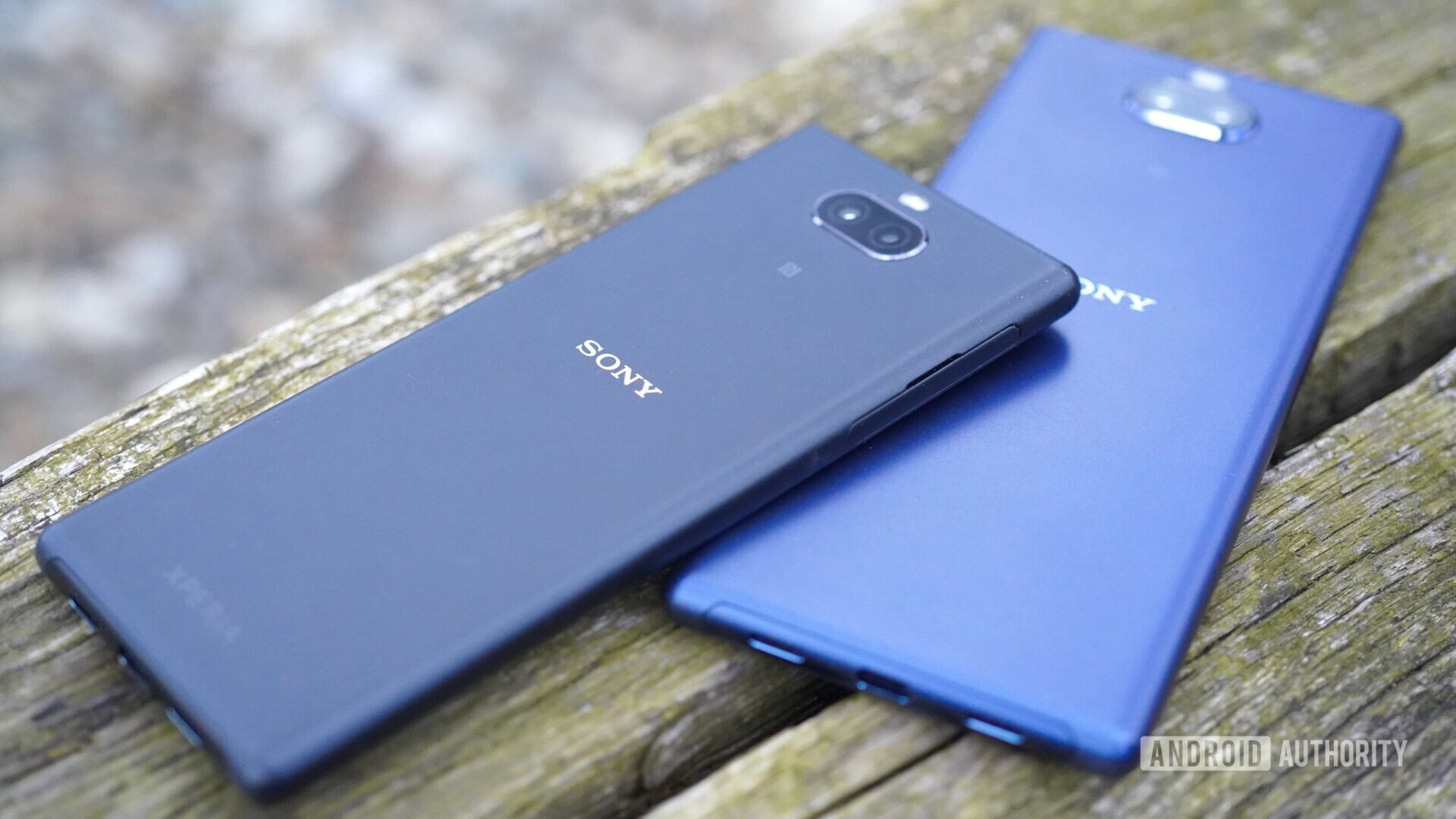
Sony Xperia 10 and Xperia 10 Plus review: Charting a new path for the smartphone
Published onApril 12, 2019
Sony Xperia 10 and Xperia 10 Plus
What we like
What we don't like
Our scores
Sony Xperia 10 and Xperia 10 Plus
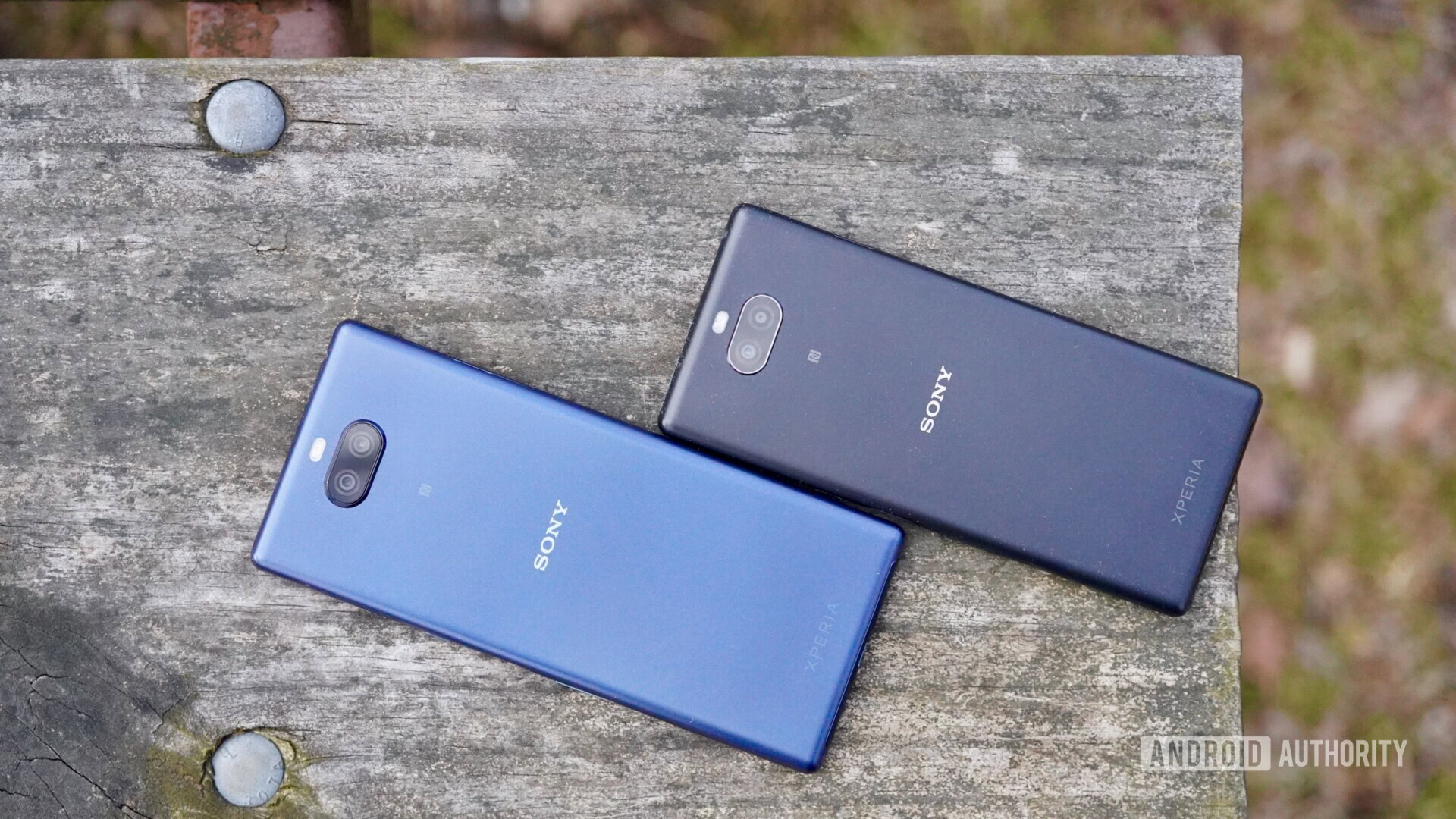
Sony is looking to change the conversation concerning how modern phones are used. The company’s 2019 lineup, which includes the Sony Xperia 10 and Xperia 10 Plus, takes a brave approach with a new aspect ratio for the screen that in turn gives the phones a unique appearance when compared to their peers.
With a focus on video consumption and multitasking, the latest Xperia phones from Sony may see everyone tipping their phones sideways more often. Is this the future of smartphones?
Find out in Android Authority’s Sony Xperia 10 Plus review.
Sony Xperia 10 and 10 Plus review: The big picture
You can’t blame Sony for seeking some attention. For years the company has trotted out respectable, but ultimately forgettable, mid-range phones. The Xperia XA series filled a vital role on Sony’s lineup thanks to their good looks, capable performance, and affordable price points. These positive characteristics, however, haven’t necessarily led to the sales success Sony wants or needs.
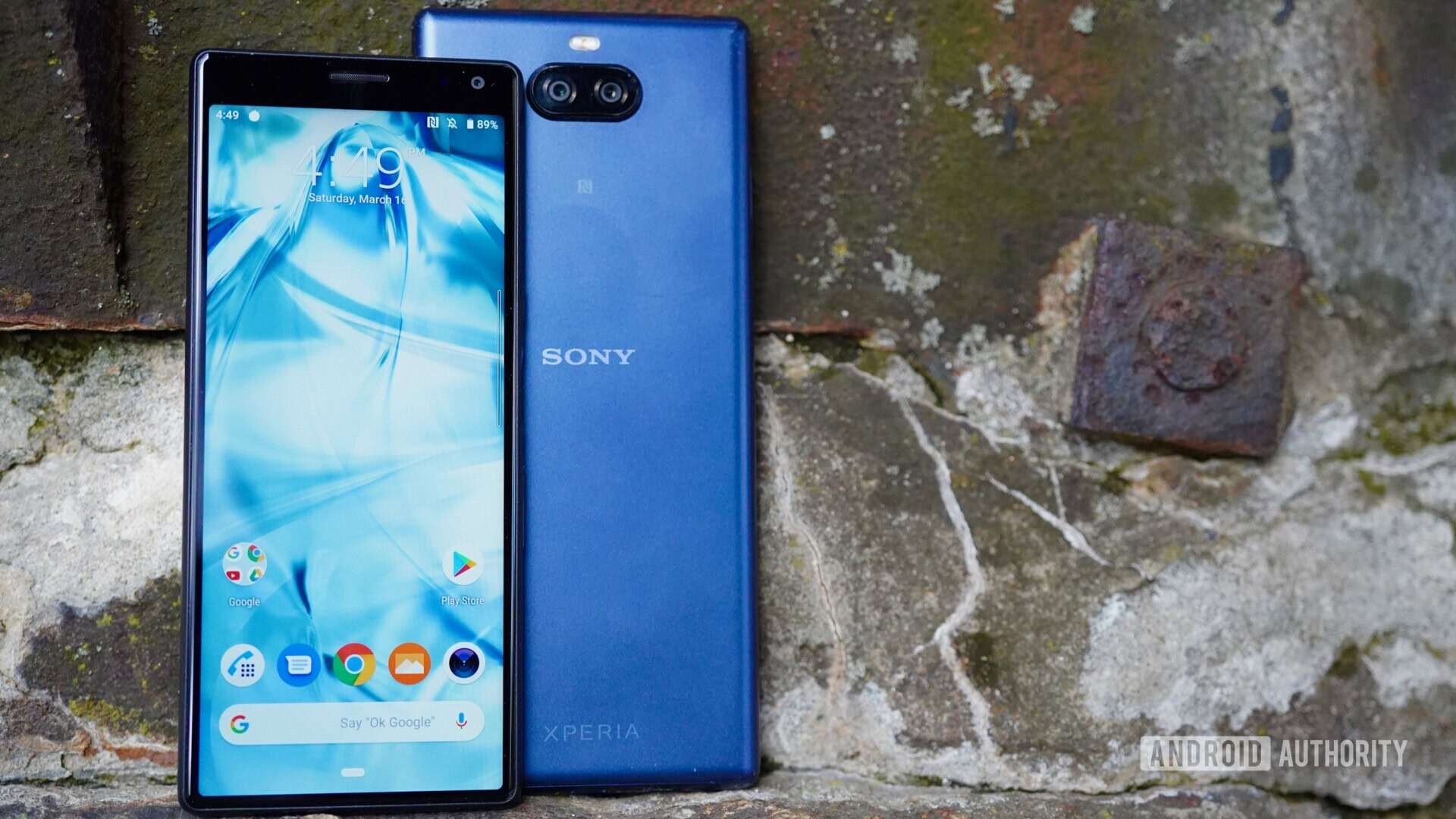
The Sony Xperia 10 and 10 Plus show Sony pivoting. The company has moved its entire line of 2019 devices to a new aspect ratio and has honed its marketing around the “super widescreen” display. (Whether the new screens are super wide or super tall is up to you to decide.)
The 10 and 10 Plus may share their basic appearance with Sony’s Xperia 1 flagship, though they dial the specs way back to reach mid-market prices. With retail cost coming in at around $325 for the 10 and $375 for the 10 Plus, these phones find themselves competing with the likes of the Samsung Galaxy A8, Moto G7, and Nokia 7.1.
Design
- Xperia 10: 156 x 68 x 8.4mm
- 162g
- Xperia 10 Plus: 167 x 73 x 8.3mm
- 180g
- Polycarbonate unibody
- Nano SIM /MicroSD memory card
- USB-C
- 3.5mm headphone jack
- Fingerprint reader (side)
- Black, Silver, Navy, Pink (10), Gold (10+)
There’s no question the Sony Xperia 10 and Xperia 10 Plus stand out. The 21:9 aspect ratio used for the screen mandates a long, stretched body. In fact, the phones are more than twice as tall as they are wide. The larger 10 Plus is taller even than the Galaxy Note 9. I’d call the look a bit gawky. It will take some time to adjust to their unique appearance.
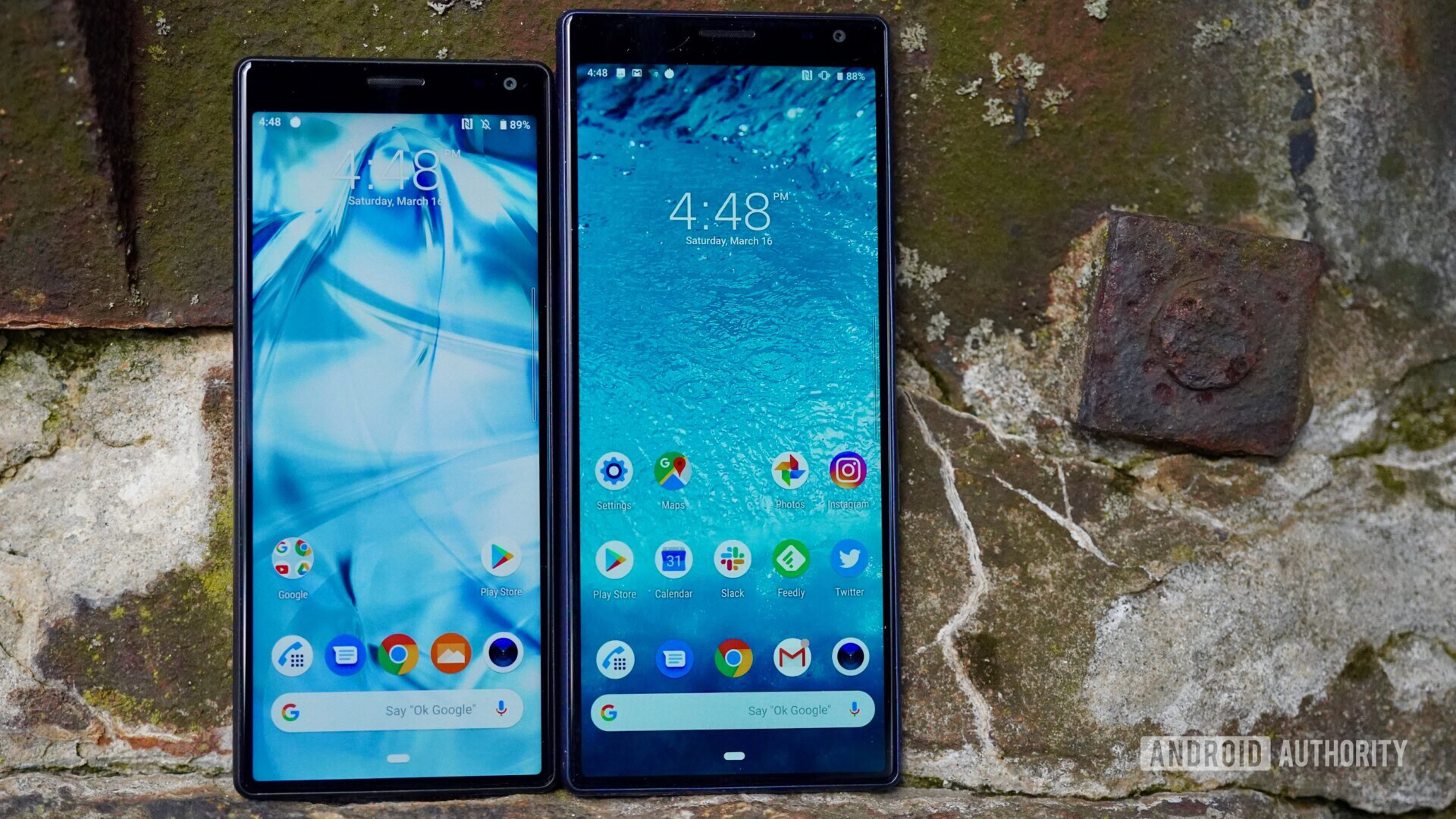
Apart from the size and shape, the Xperia 10 and 10 Plus are rather simplistic as far as the design is concerned. Sony opted for a one-piece polycarbonate shell that forms the sides and rear panel. No matter which of the color options you select, the Xperia 10 has a metallic finish that has a pleasing texture. The chassis almost looks like it’s metal. Almost.
Some might call the four corners a bit on the pointy side and they wouldn’t be wrong. This is typical Sony design. I do like the way the sides of the phones are rounded, as this makes them more comfortable to hold and use.
There’s no question the Sony Xperia 10 and Xperia 10 Plus stand out.
Gorilla Glass forms the entire face of the phone. It has what phone makers like to call a “2.5D” shape to it, meaning the glass curves slightly where it joins the chassis in order to give it a more seamless feel. The Xperia 10 and 10 Plus are stronger than your average all-glass device. They aren’t rugged, but the plastic shell means they’re less likely to shatter when dropped. I’m pleased with the quality of the materials and the tightness with which they’ve been fitted together. Sadly these devices are not waterproof, so keep them away from the pool or local fishing hole.
Sony gave the phones a regular set of ports and controls. For example, a 3.5mm headphone jack is on top and a USB-C port is on the bottom. The USB port and the nearby speakers are housed in a small metal strip that forms part of the bottom edge. Sony says this part of the device is metal for added durability.
A combo SIM/memory card tray is located on the left edge. I’ve always appreciated that the SIM trays on Sony phones can be removed with your thumbnail, rather than a SIM tool. Score 1 for ease of use. In some markets, the phones will have support for two SIM cards, instead of a SIM and microSD.
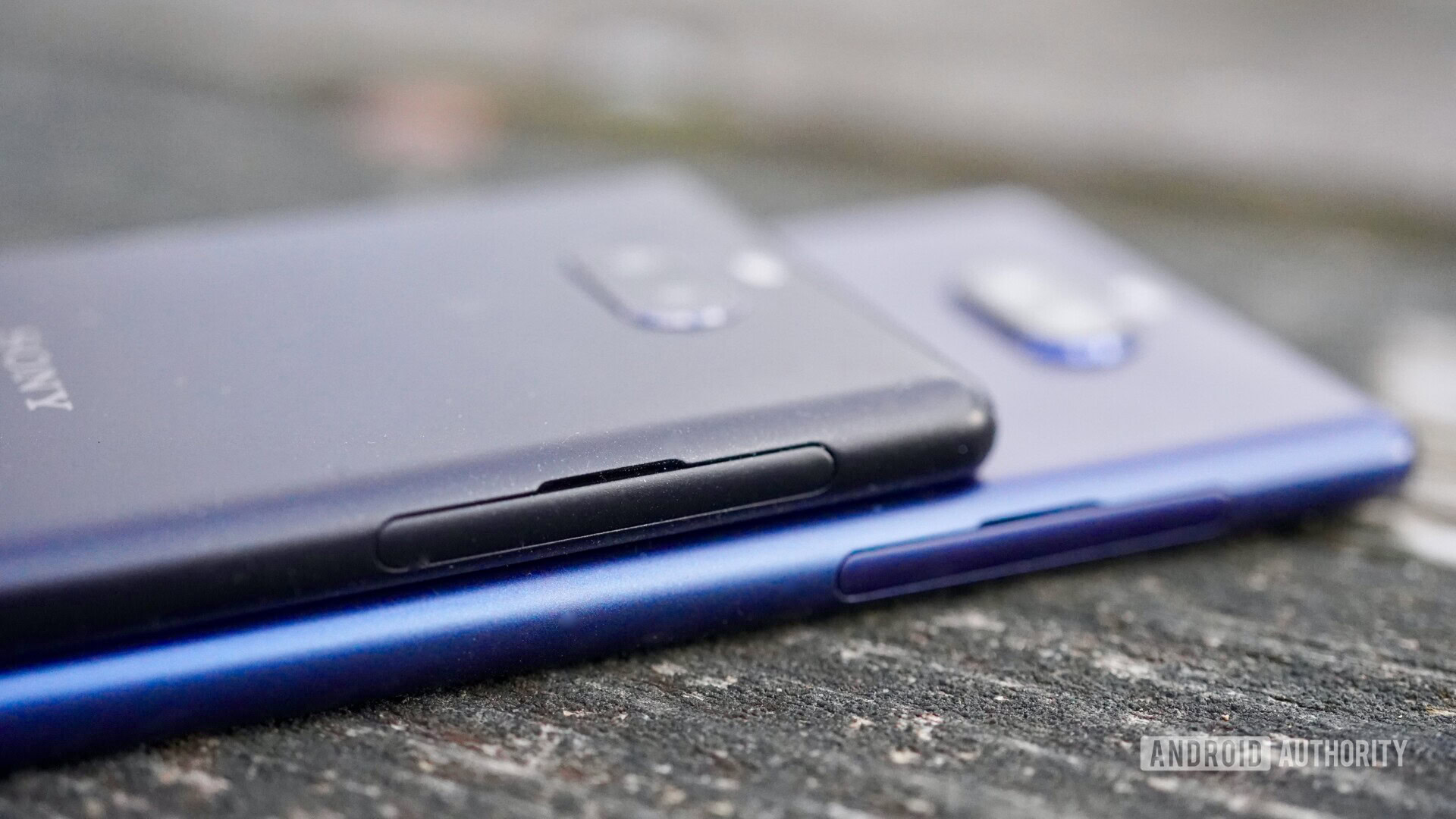
Sony decided to put the fingerprint reader on the right edge of the phone. I find this is a great compromise when the alternative is no reader at all or, worse, under the display glass. It was a breeze to train and use. The fingerprint reader functioned accurately and quickly. The power button is above the fingerprint reader and the volume toggle is below it. I only mention these because the volume toggle, in particular, is off. The action is mushy and the toggle produces a really loud clicking sound when pressed. This is true of both the 10 and the 10 Plus.
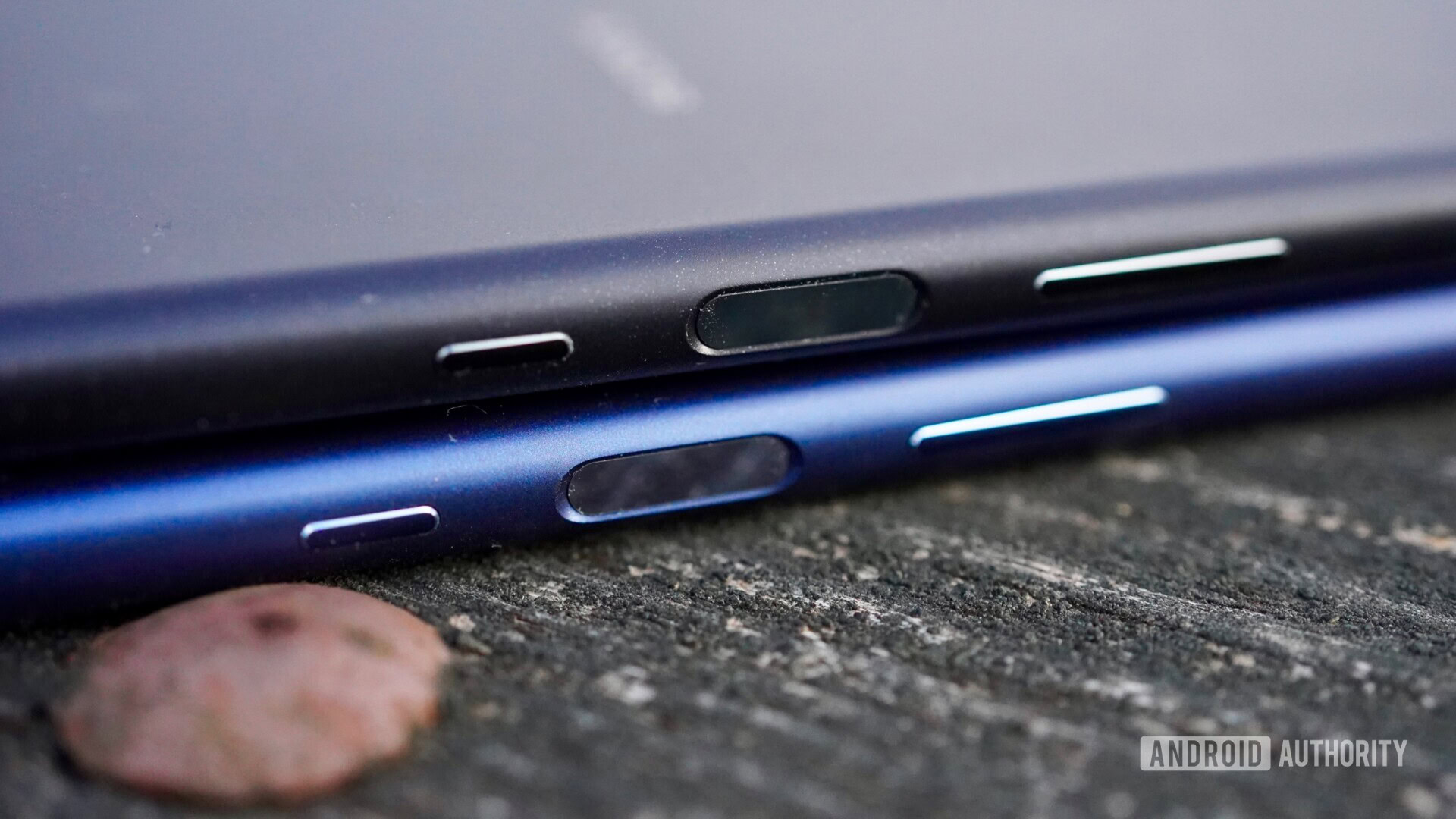
The rear panel is somewhat spartan. The plastic is flat from side to side and only interrupted by the twin camera and LED flash near the very top.
As our Sony Xperia 10 Plus review shows, the company has created some fine hardware, particularly considering the affordable prices.
Display
- Xperia 10: 6-inch Full HD+ LCD
- 2,520 x 1080 pixels
- 457ppi
- 21:9 aspect ratio
- Xperia 10 Plus: 6.5-inch Full HD+ LCD
- 2,520 x 1080 pixels
- 421ppi
- 21:9 aspect ratio
The extra wide (or tall) displays are the main selling point of the Xperia 10 and Xperia 10 Plus. There’s no question these screens define the experience, but I question whether or not this aspect ratio will truly take off as Sony hopes.
Why 21:9? Sony insists this is where video content is headed. The majority of today’s television content is created in the common 16:9 aspect ratio, but movies and, according to Sony, more TV shows are headed to the 21:9 format. YouTube, for example, still mostly defaults to 16:9, but Netflix often offers movies in 21:9.
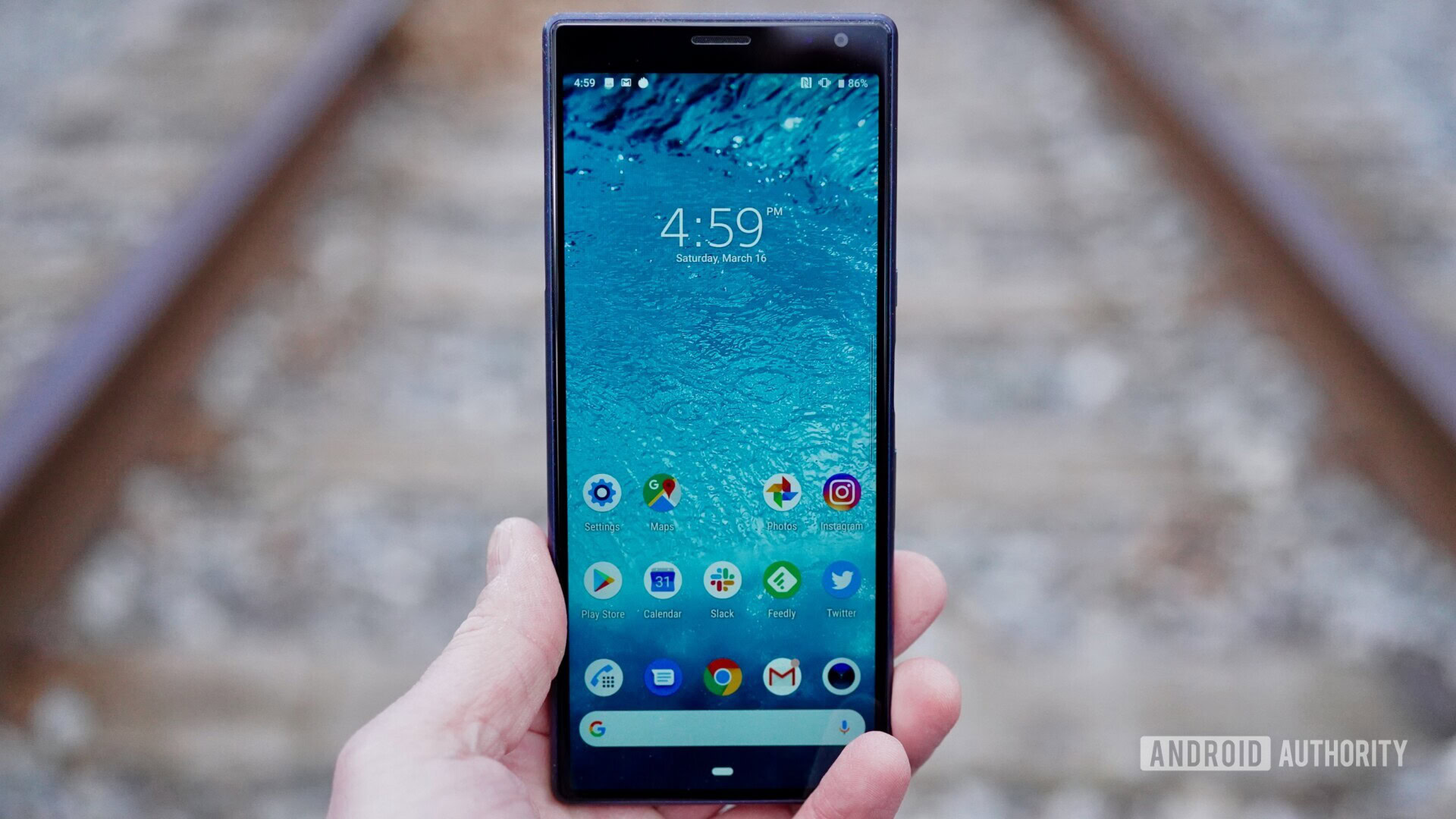
The 16:9 aspect ratio itself has already fallen out of favor with phone makers. Samsung, LG, Apple, OnePlus, Huawei, and myriad others have already shifted to 18:9 or 19.5:9 depending on their design. With a 2:1 (18:9) aspect ratio or greater, phones can better support split-screen multitasking.
The idea behind 21:9 on a phone appears to be Sony’s desire to get rid of the black bars that are often seen above and below the content when a 21:9 movie is viewed on a 16:9 or 18:9 screen. In other words, Sony wants its phones to show the entire film on the whole screen without any cropping or zooming. I’m not sure consumers are clamoring for this. I know I’m not. I guess Sony wants to be ahead of the curve?
Why 21:9? Sony insists this is where video content is headed.
The Xperia 10 series screens differ only in size and pixel density. These LCDs easily meet the expectations of devices in this price range. The narrower width of the display means pixel density is actually pretty good. Resolution is tight enough so on-screen elements really stand out. The home screen icons, for instance, are so well defined they almost appear to be floating.
Color is accurate. These LCDs don’t push the pixels toward oversaturation, though you have some control over this. The default display is “standard mode” and it helps photos and videos stand out just a bit more. You can opt for “super-vivid mode” which maximizes color for video content. Video does look more vibrant with this mode activated. You can turn this feature off altogether, as well, and colors will appear a bit more realistic.
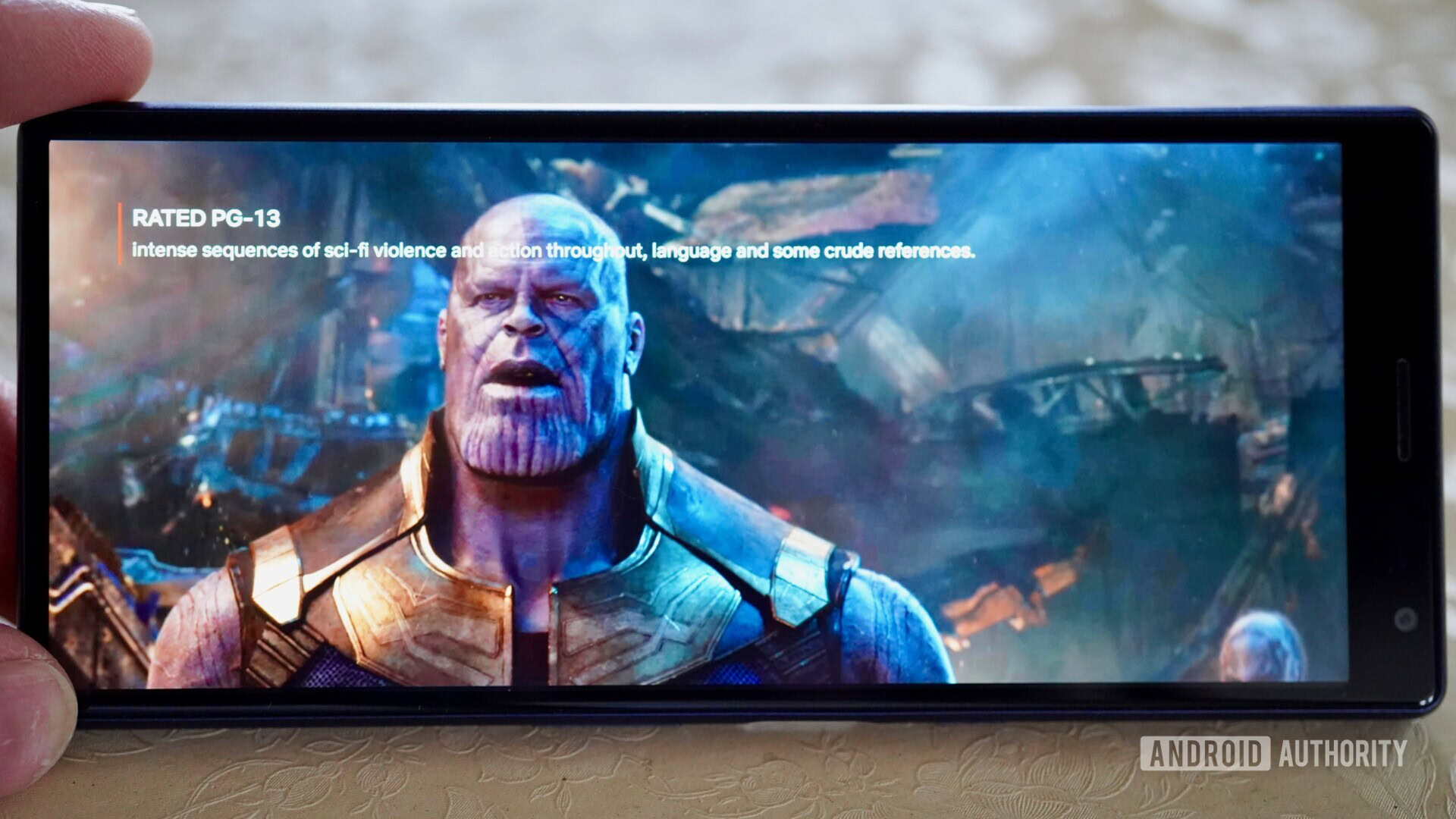
You also have control over white balance, something few phones offer. The Xperia 10 and Xperia 10 Plus have three white balance presets (warm, standard, cool), as well as a user-customizable option.Brightness is crazy good. Even set at 50%, the screen pushes plenty of light. Cranking it up all the way is practically like turning on a beacon. Viewing angles are excellent.
Bottom line, yes, Netflix flicks often fill the entire 21:9 display and look very good on the Xperia 10 and Xperia 10 Plus.
Performance
- Xperia 10: Qualcomm Snapdragon 630
- Adreno 508 GPU
- 3GB RAM
- 64GB storage
- Xperia 10+: Qualcomm Snapdragon 636
- Adreno 509 GPU
- 4GB RAM
- 64GB storage
You don’t buy mid-range phones for their blistering benchmark performance, which is a good thing ‘cause the Xperia 10 and Xperia 10 Plus struggled just a bit. I’m surprised by just how much.
Both phones have a Snapdragon 600 series processor on board. These aren’t the top-tier silicon from Qualcomm, but they aren’t low-end either. The 630 and 636 should deliver better-than-average results. In the case of the Xperia 10 and 10 Plus, it would appear they do not.
The Xperia 10 scored 1,341 on 3D Mark, 87855 on AnTuTu, and 882 on GeekBench. These numbers put the 10 in the bottom 20%.
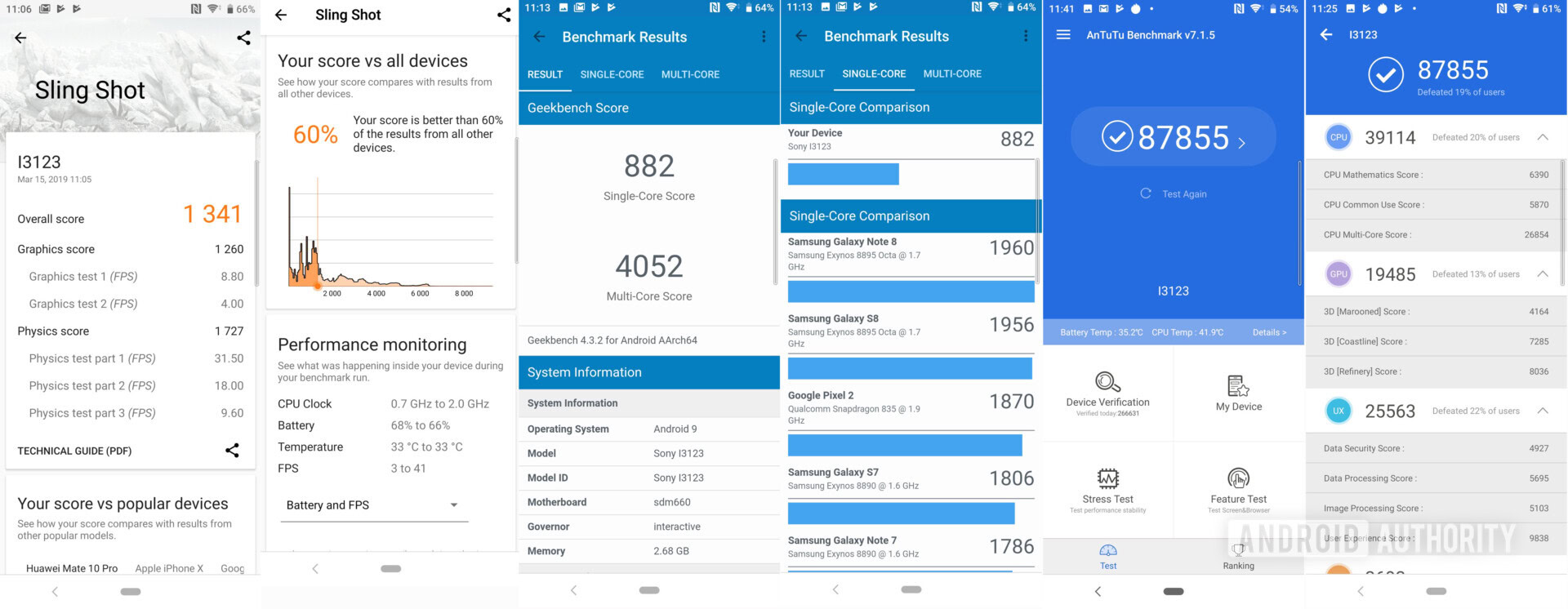
The Xperia 10 Plus scored 1469 on 3DMark, 117586 on AnTuTu, and 1346 on GeekBench. These results put the phone in the bottom 30% when compared to other phones. To find other scores these low, you’d have to go to 2016-era phones such as the OnePlus 3 or Galaxy S6.
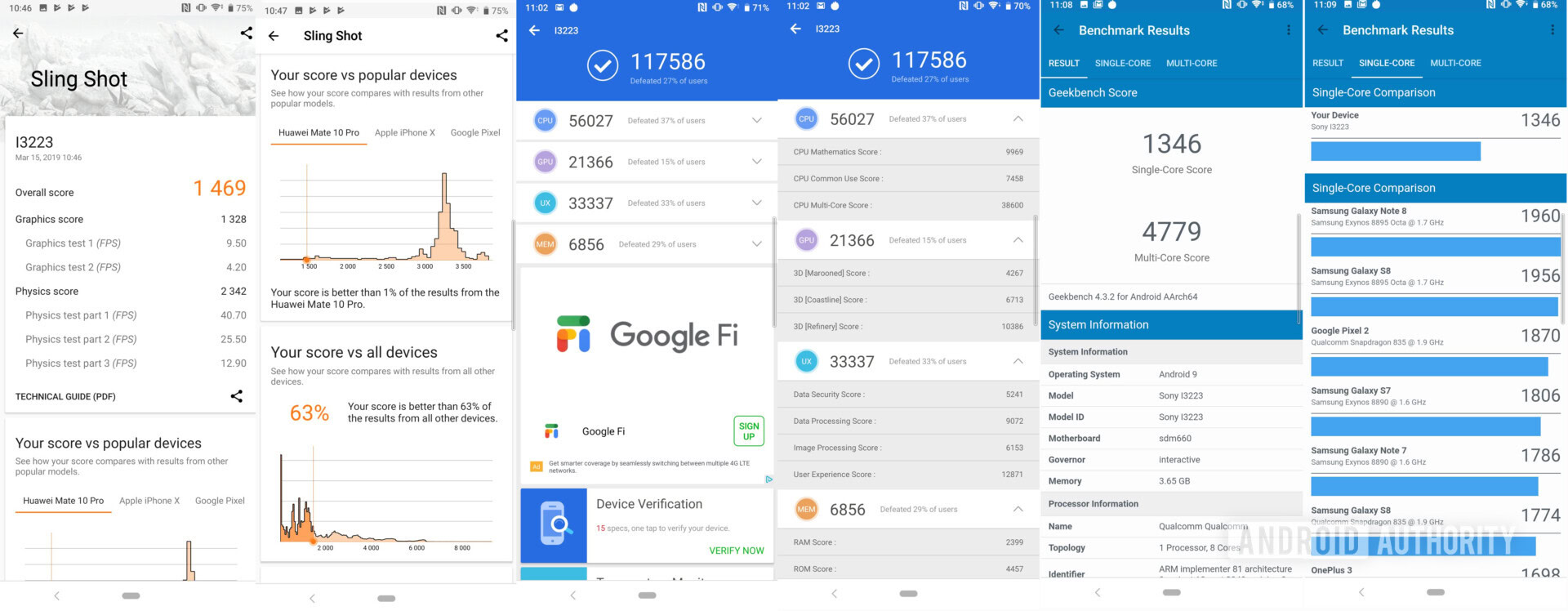
Crucially for Sony, numbers on benchmarks aren’t everything. Despite the scores I saw, the devices ran perfectly well when it came to everyday apps and tasks. I didn’t see any lagging, stuttering, or app crashes. The phones were rock solid and did everything without hesitation. So ¯\_(ツ)_/¯.
Battery
- Xperia 10: 2,870mAh
- Xperia 10 Plus: 3,000mAh
Sony made sure the Xperia 10 and Xperia 10 Plus have batteries that are in line with those of competing devices not only in size, but it longevity.
After using both phones for a week, I found each capable of delivering a day of battery life. The Xperia 10’s slightly smaller battery pushed just as hard as the Xperia 10 Plus’s larger battery. The phones offered equivalent battery life.
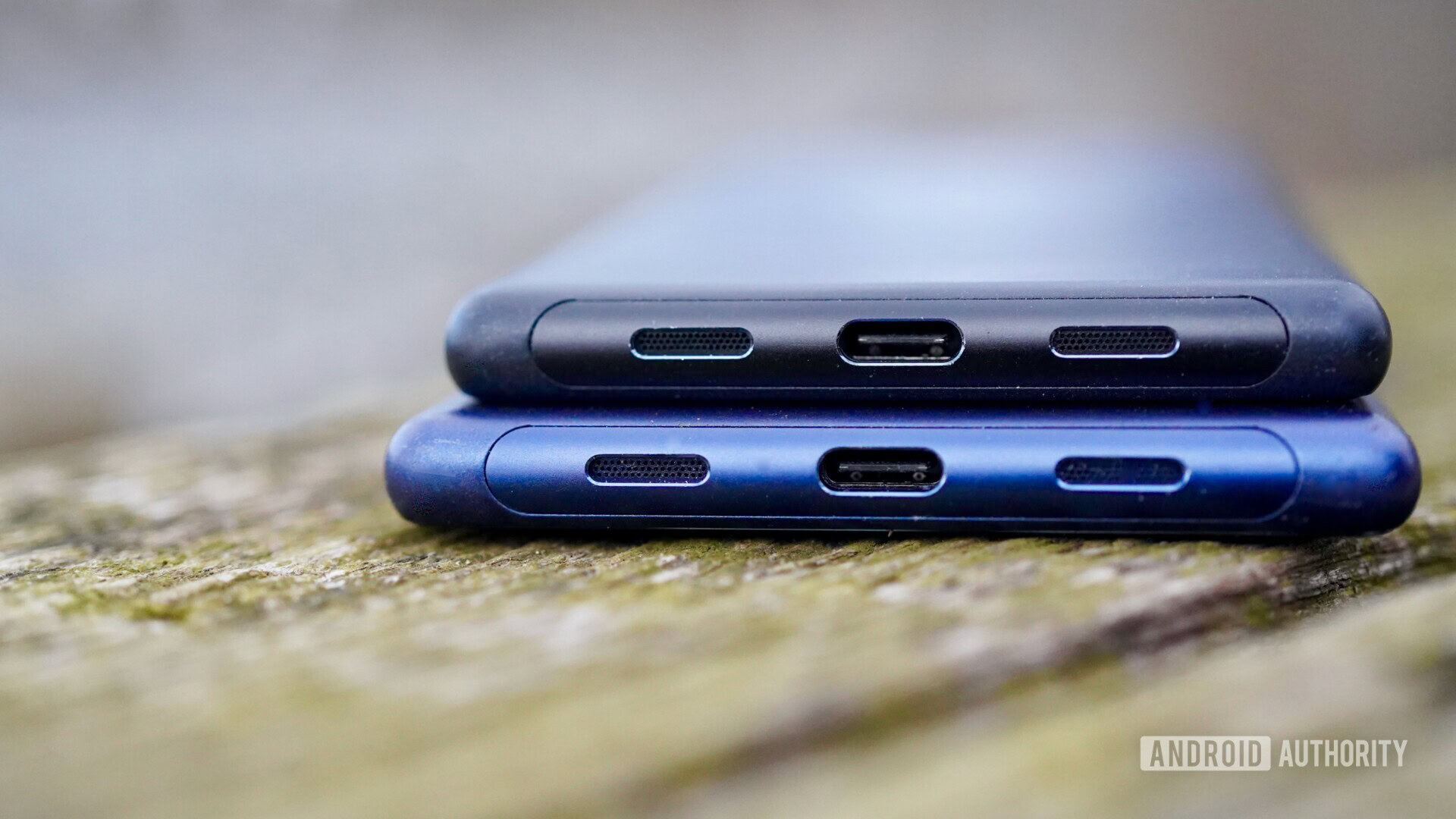
There was little room to spare. The phones were often close to their reserve come the end of the day under normal operating conditions. That means they dipped below 20%. Heavy usage throughout the day pushed them to 10%, which is the danger zone.
The good news here is that Sony includes excellent battery software to help manage your power needs. The Stamina Mode, when activated, easily adds several hours of battery life. It does this by reducing screen brightness, reducing notifications, scaling back processor output, and turning off extraneous radios. If you truly run into trouble, Ultra Stamina Mode will quite literally give you days of extra battery life — as long as you don’t mind the phone operating with just a few core apps.
There’s no wireless charging, which is fine considering the phones’ price points.
Camera
Rear Cameras:
- Xperia 10: 13MP f/2 standard
- 5MP f/2.4 wide angle
- Xperia 10 Plus: 12MP f/1.75 standard
- 8MP f/2.4 telephoto
Front Camera:
- 8MP f/2.0 wide-angle
- Portrait selfie
- HDR
Features:
- Bokeh
- ISO 12,800 (photo)
- ISO 3,200 (video)
- Steadyshot
- HDR
- 120fps slow motion
- 4K video at 60fps
Sony gave each phone a dual-camera setup on the rear and a single camera on the front. The specs of each differ a little, but the feature list is the same. Interacting with the camera app is a breeze. It’ll open with a double-press of the screen lock button, and it does so in a jiffy. Quick controls are on the left side of the viewfinder and the shutter/mode buttons are on the right.
Shooting modes run the norm for a Sony device. In addition to standard photo and video capture, you have portrait selfie, bokeh, slow motion, AR effect, manual mode, creative effect, and panorama. The AR effect lets you dress up your photos with augmented reality stuff, such as dinosaurs, while the creative effect lets you apply live filters to photos/video, such as pencil drawing, vintage color, and so on.
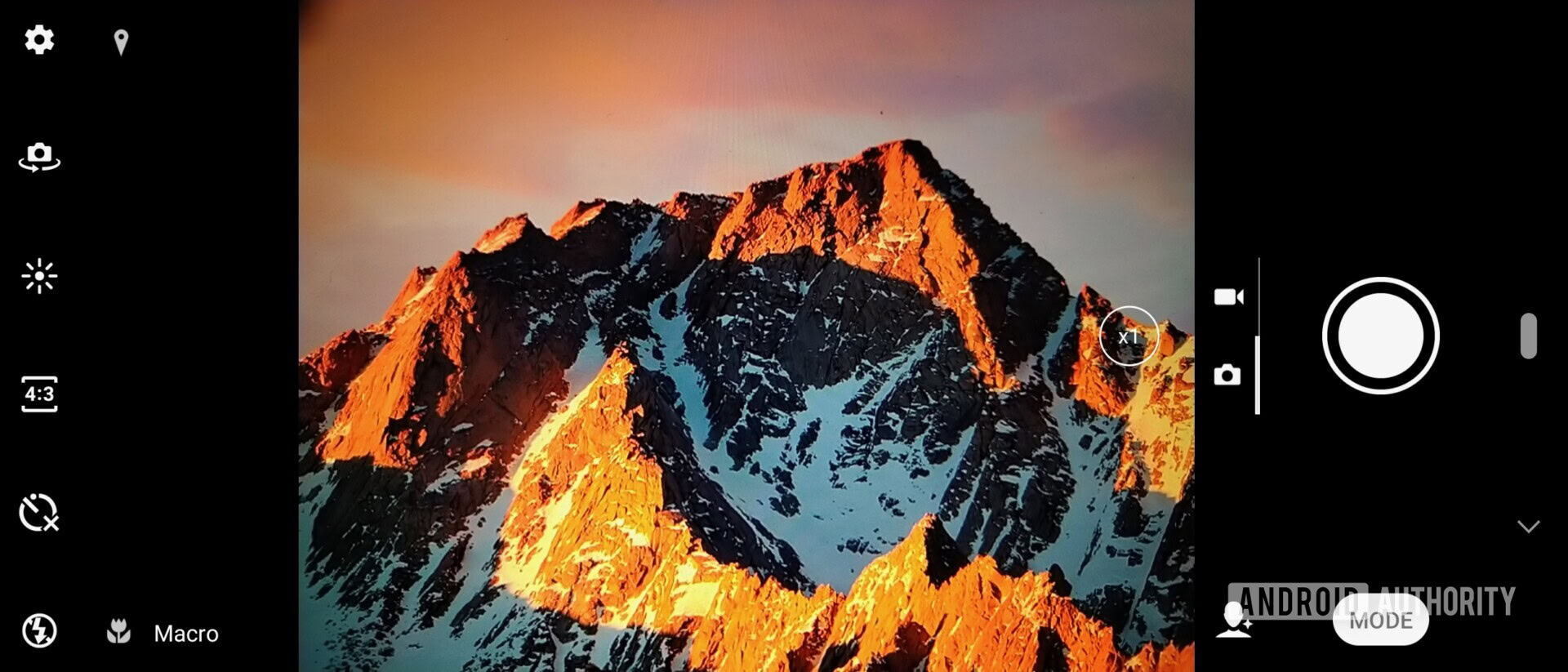
The manual mode lets you control autofocus, shutter speed, ISO, brightness, and white balance. I wish shutter speeds could hold for longer than 1 second.
Few phones flaunt a flash with five functions. The Xperia 10 and 10 Plus allow you to set the flash to on, off, fill-flash, red-eye reduction, and flashlight. Totally dig this. The fill flash, in particular, is helpful when you’re taking nighttime portraits and you don’t want to totally overexposure the subject.
A note on aspect ratios. If you want the full pixel count of the camera sensor, you need to opt for the 4:3 aspect ratio. This is the default setting. You can crop down to 16:9 (to fit your TV or computer), 1:1 (for Instagram), and, yes, 21:9 (to fill the screen of the phone itself.) Each of these alternate ratios reduces the total number of pixels captured.
The Sony Xperia 10 and Xperia 10 Plus shoot very good photos when compared to phones in this price range.
How do the pix look? I must first point out that the phones do have different CPUs/GPUS and different sensors for the main cameras. Despite everything else being the same, these two disparities in the hardware do in fact show up in the photos — if only a little.
Pictures I captured with the Xperia 10 often skewed a bit warm (more yellow), particularly with the main sensors. The selfie cam showed more natural-looking results. Focus was generally sharp, and exposure was mostly good. The Xperia 10 had a little trouble with photos that had a lot of contrast (dark and bright areas). For example, the tree below is a bit washed out because the camera over-compensated for the bright background.
The shots I got with the Xperia 10 Plus showed better exposure, better white balance, but focus was less consistently sharp. You can see some softness here and there in the shots below.
Selfies turned out okay. I don’t look too freakish in the selfie portrait, though the bokeh effect is clearly not perfect. At least skin tone and exposure are good.

The phones let you shoot video up to 4K and up to 60fps. I was mostly pleased with the results. Some video was a little grainy.
In sum, the Sony Xperia 10 and Xperia 10 Plus shoot very good photos when compared to phones in this price range, and do so with an app that’s easy to master.
Full resolution samples are available for the Xperia 10 here and the Xperia 10 Plus here.
Software
- Android 9 Pie
Sony launched both phones with Android 9 Pie. This is the latest operating system from Google. The devices run a mostly clean version of Android, and that’s a good thing as far as I am concerned. The biggest differences you’ll spot are background colors and some fonts. The core mechanics of the OS are unchanged. In other words, you have a home screen, app drawer, Quick Settings / notification shade, and the pill-based UI for which Pie is known.
There are some unique features worth pointing out. As you might guess, it’s really darned difficult to reach the top of the display on these tall, lanky phones. Calling up one-handed operation is a cinch and helps a lot. Double tap the home button and the entire desktop shrinks. It is easier to interact with the notification shade, for example, when the UI is shrunk. Another double-tap sends the desktop back to full size.
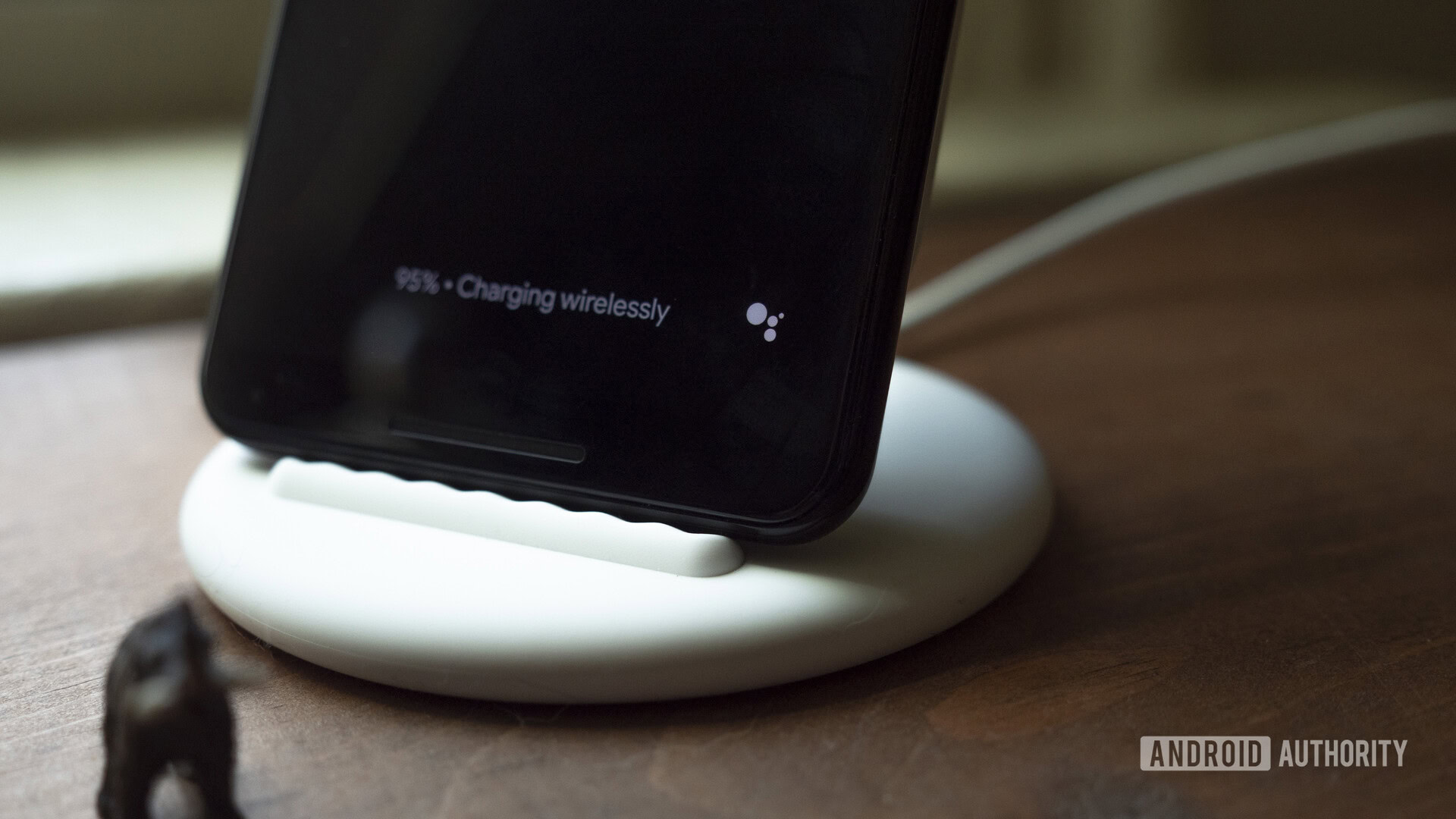
There’s also Side Sense. This feature is similar to Samsung’s Edge Screen. A short bar appears on the left or right side of the screen. Double tapping the bar opens up a small window with shortcuts to several key apps and actions. I like that it’s entirely customizable.
Split-screen multitasking works really well on the tall screen. With the huge aspect ratio, you’ll enjoy larger windows when running two apps side-by-side. Sony says it is hoping to introduce a Google Voice Action so Xperia 10 and Xperia 10 Plus owners can use voice commands to open two apps at the same time. We haven’t seen that yet.
Audio
- 3.5mm headphone jack
- High-resolution audio
- DSEE HX and LDAC
- Smart amplifier
- Monaural speaker
The first music player I ever owned, the first that was just mine, was a Sony Walkman. It was the size of a tank and featured an FM/AM radio and cassette player. It was the love of my life for years, as has been most every media player I’ve owned over the decades. Nothing is as cherished by me as much as the ability to bring music with me everywhere I go.
That’s why I’m happy to tell you that Sony’s Xperia 10 and 10 Plus gots the music goods. What you need to know is this: The 10 and 10 Plus are only limited by your headphones.
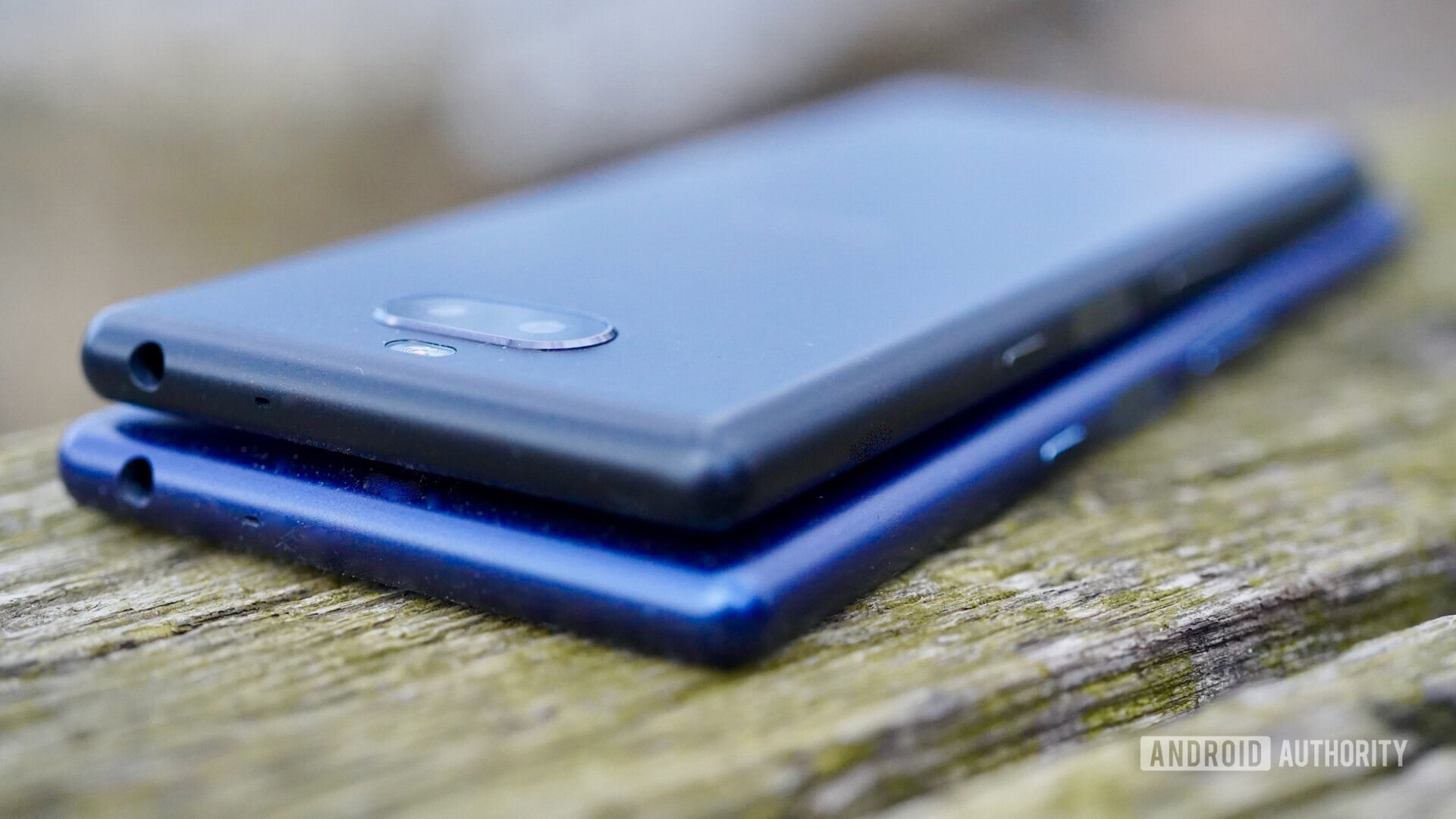
The software lets you do things like upgrade the quality of compressed files, optimize sound settings for your environment, customize a 5-band equalizer, and balance the volume of your media. These tools are optional, but do make a difference if you’re willing to futz around a bit.
Even better, this goes for wired and wireless headphones. With aptX on board, your compatible Bluetooth headphones can produce sound that is cleaner and more full.
My biggest complaint is that there’s only a single loudspeaker, meaning the audio comes from either the left or the right when you’re holding the phone sideways to watch video. The speaker itself does a very good job.
Phone calls on AT&T and T-Mobile’s networks sounded really good.
Sony Xperia 10 and Xperia 10 Plus specifications
| Sony Xperia 1 | Sony Xperia 10 | Sony Xperia 10 Plus | |
|---|---|---|---|
Display | Sony Xperia 1 6.5-inch 4K HDR OLED 21:9 aspect ratio X1 for mobile Creator mode | Sony Xperia 10 6-inch LCD FHD+ 21:9 aspect ratio | Sony Xperia 10 Plus 6.5-inch LCD FHD+ 21:9 aspect ratio |
SoC | Sony Xperia 1 Qualcomm Snapdragon 855 Mobile Platform | Sony Xperia 10 Qualcomm Snapdragon 630 Mobile Platform | Sony Xperia 10 Plus Qualcomm Snapdragon 636 Mobile Platform |
GPU | Sony Xperia 1 Adreno 640 | Sony Xperia 10 Adreno 508 | Sony Xperia 10 Plus Adreno 509 |
RAM | Sony Xperia 1 6GB | Sony Xperia 10 3GB | Sony Xperia 10 Plus 4GB |
Storage | Sony Xperia 1 128GB MicroSD expansion up to 512GB | Sony Xperia 10 64GB MicroSD expansion up to 512GB | Sony Xperia 10 Plus 64GB MicroSD expansion up to 512GB |
Cameras | Sony Xperia 1 Rear cameras: 12MP wide-angle lens, 25mm OIS, Dual PD 12MP Telephoto lens, 52mm OIS 12MP Super-wide lens, 16mm Front camera 8MP FF BIONX for mobile HDR recording Cinema Pro | Sony Xperia 10 Rear cameras: 13MP 1/3.0" 5MP 1/4' Bokeh ISO 12800 (photo) ISO 3200 (video) 4K movie recording Front camera 8MP 1/4.0" ISO 3200 (photo) ISO 1600 (video) | Sony Xperia 10 Plus Rear cameras: 12MP 1/2.8" 8MP 1/4' Optical Zoom + Bokeh ISO 12800 (photo) ISO 3200 (video) 4K movie recording Front camera 8MP 1/4.0" ISO 3200 (photo) ISO 1600 (video) |
Audio | Sony Xperia 1 Dolby Atmos Hi-res Audio DSEE HX LDAC Stereo speaker Stereo sound recording Smart amplifier Sony's Dynamic Vibration system | Sony Xperia 10 High-resolution audio DSEE HX LDAC Smart amplifier Monaural speaker Stereo recording | Sony Xperia 10 Plus High-resolution audio DSEE HX LDAC Smart amplifier Monaural speaker Stereo recording |
Durability | Sony Xperia 1 Corning Gorilla Glass 6 IP68 | Sony Xperia 10 Corning Gorilla Glass 5 | Sony Xperia 10 Plus Corning Gorilla Glass 5 |
Biometrics | Sony Xperia 1 Fingerprint sensor (side) | Sony Xperia 10 Fingerprint sensor (side) Side sense | Sony Xperia 10 Plus Fingerprint sensor (side) Side sense |
Network | Sony Xperia 1 SCA LTE CAT 19 4x4 MIMO 11a/ac/b/g/n | Sony Xperia 10 3CA LTE CAT12/13 | Sony Xperia 10 Plus 3CA LTE CAT12/13 |
Connectivity | Sony Xperia 1 NFC Bluetooth 5.0 USB-C/USB.3.1 | Sony Xperia 10 NFC Bluetooth 5.0 USB-C/USB.2.0 | Sony Xperia 10 Plus NFC Bluetooth 5.0 USB-C/USB.2.0 |
Battery | Sony Xperia 1 3,330mAh | Sony Xperia 10 2,870mAh | Sony Xperia 10 Plus 3,000mAh |
Software | Sony Xperia 1 Android 9 Pie | Sony Xperia 10 Android 9 Pie | Sony Xperia 10 Plus Android 9 Pie |
Dimensions and weight | Sony Xperia 1 167x72x8.2mm | Sony Xperia 10 156x68x8.4mm 162 | Sony Xperia 10 Plus 167x73x8.3mm 180g |
Colors | Sony Xperia 1 Black, White, Gray, Purple | Sony Xperia 10 Black, Silver, Navy, Pink | Sony Xperia 10 Plus Black, Silver, Navy, Gold |
Final thoughts and where to buy
I have to give Sony credit for taking a bit of a risk with the Xperia 10 and Xperia 10 Plus. The 21:9 displays make them stand out — literally, because they’re so tall. The awkward appearance aside, these phones have appealing displays, strong chassis, and table-stakes features like headphone jacks and fingerprint readers. Battery life just makes the mark.
The Android 9 Pie software runs well on these phones, despite the below-average benchmark scores, and Sony’s customizations actually do assist with usability. The camera app is powerful and the 10 and 10 Plus manage to take above-average photos for the price.
The Sony Xperia 10 and Xperia 10 Plus are available from Amazon, Best Buy, B&H Photo Video, and Focus. This concludes our Sony Xperia 10 Plus review.